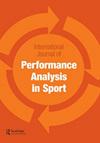生理、感知和表现变量部分预测柔道的起搏
IF 1.6
4区 教育学
Q1 Health Professions
International Journal of Performance Analysis in Sport
Pub Date : 2023-07-19
DOI:10.1080/24748668.2023.2238166
引用次数: 0
摘要
摘要本研究以运动员体能为基础,对柔道比赛中的主要动作进行评估。男性成年柔道运动员41名(23.3±5.8岁);78.9±11.6 kg;174.7±5.9 cm)进行人体测量和测试电池,以评估下半身和上半身有氧和无氧能量和能力,上半身动态力量-耐力,并进行一次5分钟的匹配模拟。记录时间-运动变量并用于确定运动员的起搏。通过多元回归分析,利用知觉、生理和表现变量对比赛过程中的动作进行估计。攻击频率与上肢力量耐力之间的联系证实了在比赛中发展这种高强度动作能力的相关性。有氧能力和力量与比赛中的高强度动作有关。无氧能力和有氧能力与高强度耐力动作(握力时间)呈负相关,而上身vo2峰值对其有正相关影响。奠基时间由有氧能力、上肢力量耐力和无氧能力决定。然而,这些关系的决定系数是低到中等(即0.13-0.51)。因此,生理、知觉和表现变量的不同组合可以部分地估计比赛中高强度和低强度动作的频率和时间。本文章由计算机程序翻译,如有差异,请以英文原文为准。
Physiological, perceptual and performance variables partially predict pacing in judo
ABSTRACT This study was conducted to estimate the main actions during a judo match based on athletes’ physical fitness. Forty-one male adult judo athletes (23.3 ± 5.8 years old; 78.9 ± 11.6 kg; 174.7 ± 5.9 cm) underwent anthropometric measurements and a test battery to evaluate lower- and upper-body aerobic and anaerobic power and capacity, upper-body dynamic strength-endurance and performed one 5-min match simulation. The time-motion variables were recorded and used to determine the athletes’ pacing. Perceptual, physiological, and performance variables were used to estimate the actions during the match via multiple regression analysis. The association between the frequency of attacks and upper-body strength-endurance confirmed the relevance of developing this capacity for high-intensity actions during the match. Aerobic capacity and power were related to high-intensity actions during the match. Anaerobic power and aerobic capacity were negatively related to high-intensity strength-endurance actions across the match (grip time), while upper-body VO2peak positively influenced it. Groundwork time was determined by aerobic capacity, upper-body strength-endurance, and anaerobic power. However, the coefficient of determination for these relationships was low to moderate (i.e. 0.13–0.51). Thus, different combinations of physiological, perceptual, and performance variables could partially estimate frequency and time of high- and low-intensity actions during the match.
求助全文
通过发布文献求助,成功后即可免费获取论文全文。
去求助
来源期刊

International Journal of Performance Analysis in Sport
SPORT SCIENCES-
CiteScore
4.70
自引率
4.80%
发文量
38
审稿时长
>12 weeks
期刊介绍:
The International Journal of Performance Analysis in Sport aims to present current original research into sports performance. In so doing, the journal contributes to our general knowledge of sports performance making findings available to a wide audience of academics and practitioners.
 求助内容:
求助内容: 应助结果提醒方式:
应助结果提醒方式:


